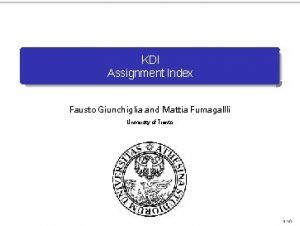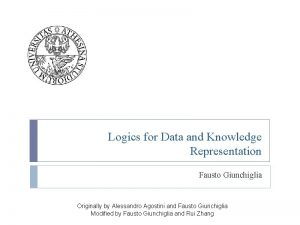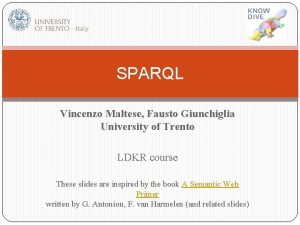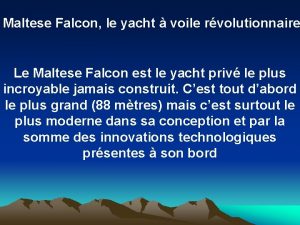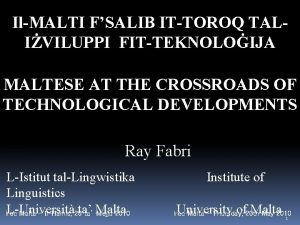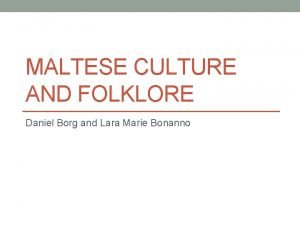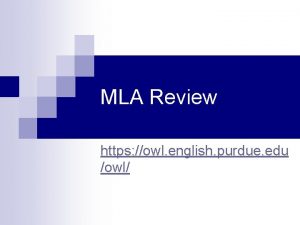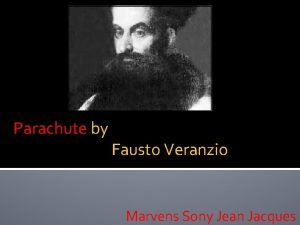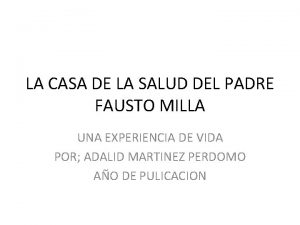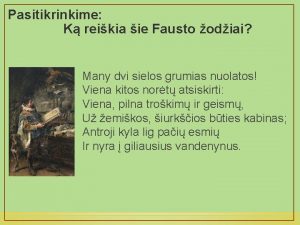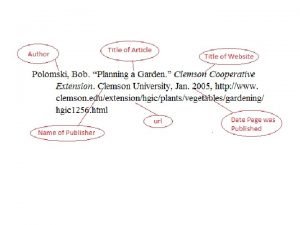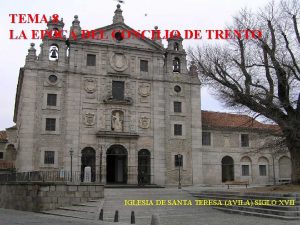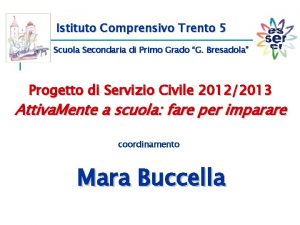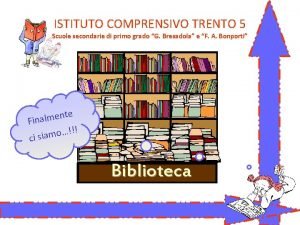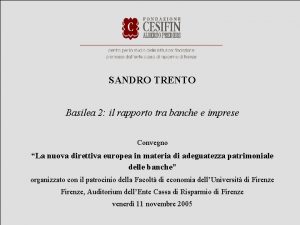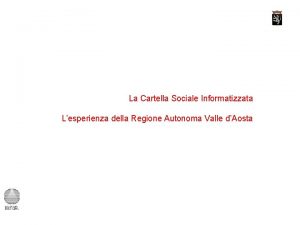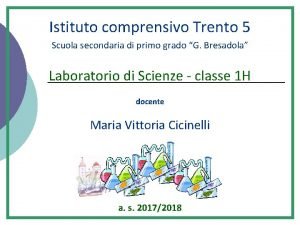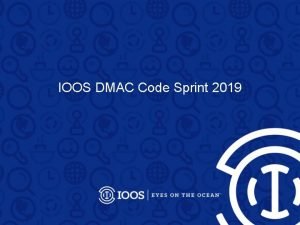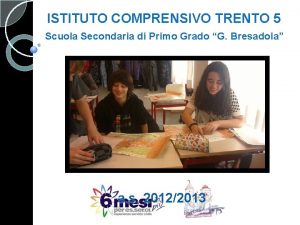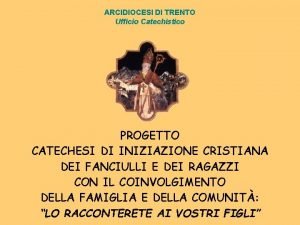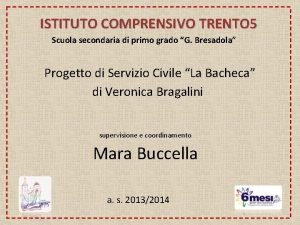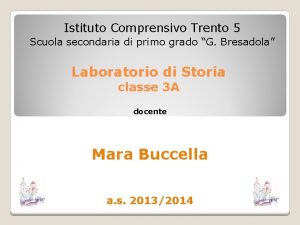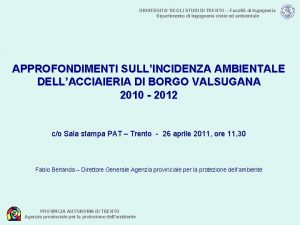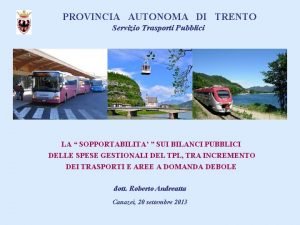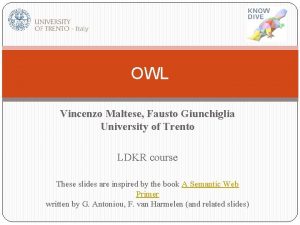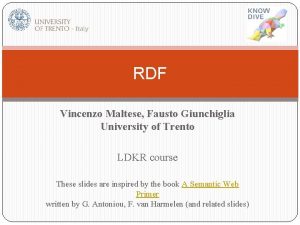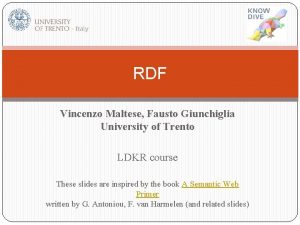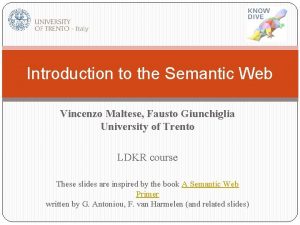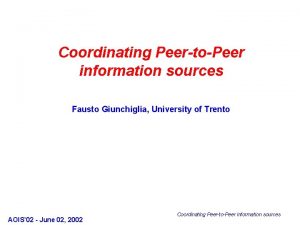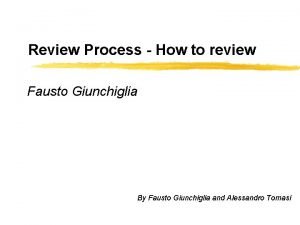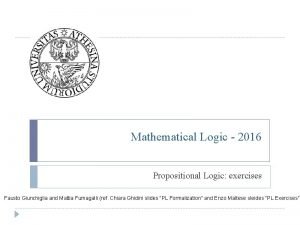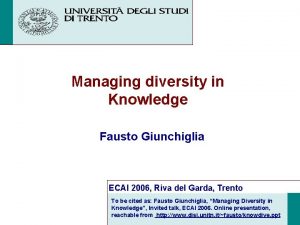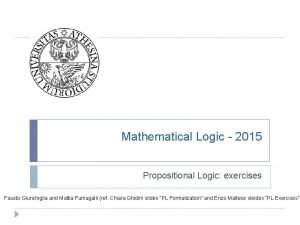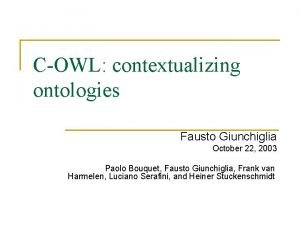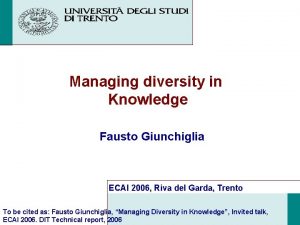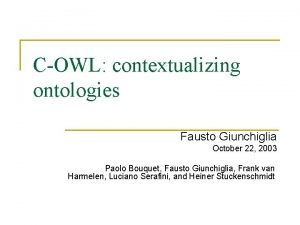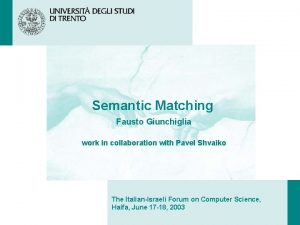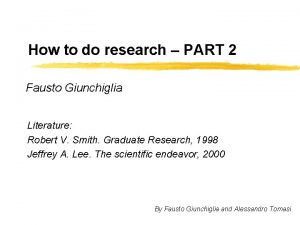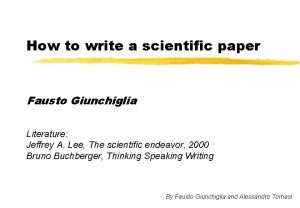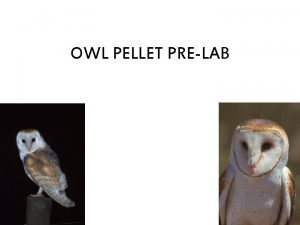OWL Vincenzo Maltese Fausto Giunchiglia University of Trento










































- Slides: 42

OWL Vincenzo Maltese, Fausto Giunchiglia University of Trento LDKR course These slides are inspired by the book A Semantic Web Primer written by G. Antoniou, F. van Harmelen (and related slides)

Roadmap Introduction The OWL Full Language OWL DL and OWL lite Exercises 2

Introduction 3 Chapter 1

Requirements for Ontology Languages Ontology languages allow users to write explicit, formal conceptualizations of domain models (i. e. formal ontologies) The main requirements are: A well-defined formal syntax Sufficient expressive power Convenience of expression Formal semantics Support for efficient reasoning A good tread-off between expressivity and efficiency OWL (Web Ontology Language) has been designed to meet these requirements for the specification of ontologies and to reason about them and their instances 4

Reasoning capabilities required Class membership If x is an instance of a class C, and C is a subclass of D, then we can infer that x is an instance of D Equivalence of classes If class A is equivalent to class B, and class B is equivalent to class C, then A is equivalent to C Disjointness and Consistency Determine that if the classes A and B are disjoint there cannot be individuals x which are instances of both A and B. This is an indication of an error in the ontology. Classification Certain property-value pairs are a sufficient conditions for membership in a class A; if an individual x satisfies such conditions, we can conclude that x must be an instance of A. 5

Limitations in the expressive power of RDF schema Range restrictions We cannot declare range restrictions that apply to some classes only (e. g. cows eat only plants, while other animals may eat meat too). Disjointness of classes We cannot declare that two classes are disjoint (e. g. male and female). Combinations of classes We cannot define new classes as union, intersection, and complement of other classes (e. g. person is the disjoint union of the classes male and female). Cardinality restrictions We cannot express restrictions in the number of relations (e. g. a person has exactly two parents, a course is taught by at least one lecturer) Meta-properties Transitive property (e. g. “greater than”) Unique property (e. g. “is mother of”) Inverse property (e. g. “eats” and “is eaten by”) 6

OWL sub-languages OWL Full OWL DL Each OWL Lite representation belongs to OWL DL Each OWL DL representation OWL Lite belongs to OWL Full Each valid OWL Lite conclusion is also valid in OWL DL Each valid OWL DL conclusion is also valid in OWL Full 7

OWL sub-languages OWL Lite trades expressivity for efficiency The less expressive of all languages (it cannot be used to express enumerated classes, disjointness, and arbitrary cardinality restrictions) It allows assigning simple cardinality constraints of kind 0 or 1 It allows encoding simple classification hierarchies (e. g. , taxonomies and thesauri) Partially compatible with RDF OWL DL is a balance between expressivity and computational completeness More expressive than OWL Lite while guarantees decidability It allows expressing all DL constructs, some of them with certain restrictions (e. g. the restriction of not making a class an instance of another class) Partially compatible with RDF OWL Full trades computational completeness for expressivity More expressive than OWL DL, maximum expressiveness (e. g. , a class can be represented also as an individual and therefore we can express properties 8 of classes) It is computationally very expensive and does not guarantee decidability

The OWL Full language 9 Chapter 1

OWL XML/RDF syntax HEADER ONTOLOGY <rdf: RDF xmlns: owl ="http: //www. w 3. org/2002/07/owl#" xmlns: rdf ="http: //www. w 3. org/1999/02/22 -rdf-syntax-ns#" xmlns: rdfs="http: //www. w 3. org/2000/01/rdf-schema#" xmlns: xsd ="http: //www. w 3. org/2001/XLMSchema#"> <owl: Ontology rdf: about=""> <rdfs: comment>An example OWL ontology </rdfs: comment> <owl: prior. Version rdf: resource="http: //www. mydomain. org/uni-nsold"/> <owl: imports rdf: resource="http: //www. mydomain. org/persons"/> <rdfs: label>University Ontology</rdfs: label> 10

Classes Defined using owl: Class that is a subclass of rdfs: Class owl: Thing is the most general class, which contains everything owl: Nothing is the empty class DISJOINT CLASSES owl: disjoint. With <owl: Class rdf: about="#associate. Professor"> <owl: disjoint. With rdf: resource="#professor"/> <owl: disjoint. With rdf: resource="#assistant. Professor"/> </owl: Class> EQUIVALENT CLASSES equivalent. Class <owl: Class rdf: ID="faculty"> <owl: equivalent. Class rdf: resource= "#academic. Staff. Member"/> </owl: Class> 11

Properties Data type properties relate objects to datatype values (ATTRIBUTES) <owl: Datatype. Property rdf: ID="age"> <rdfs: range rdf: resource= "http: //www. w 3. org/2001/XLMSchema #non. Negative. Integer"/> </owl: Datatype. Property> Object properties relate objects to other objects (RELATIONS) <owl: Object. Property rdf: ID="is. Taught. By"> <owl: domain rdf: resource="#course"/> <owl: range rdf: resource= "#academic. Staff. Member"/> <rdfs: sub. Property. Of rdf: resource="#involves"/> </owl: Object. Property> 12

Property restrictions (I) VALUE CONSTRAINT owl: all. Values. From A value constraint puts constraints on the range of the property. It corresponds to universal quantification. <owl: Class rdf: about="#first. Year. Course"> <rdfs: sub. Class. Of> <owl: Restriction> <owl: on. Property rdf: resource="#is. Taught. By"/> <owl: all. Values. From rdf: resource="#Professor"/> </owl: Restriction> </rdfs: sub. Class. Of> </owl: Class> 13

Property restrictions (II) CARDINALITY CONSTRAINT some. Values. From / owl: has. Value A cardinality constraint puts constraints on the number of values. It corresponds to the existential quantification or can indicate a specific value. <owl: Class rdf: about="#first. Year. Course"> <rdfs: sub. Class. Of> <owl: Restriction> <owl: on. Property rdf: resource="#teaches"/> <owl: some. Values. From rdf: resource="#undergraduate. Course"/> (or) <owl: on. Property rdf: resource= "#is. Taught. By"/> <owl: has. Value rdf: resource= "#949352"/> </owl: Restriction> </rdfs: sub. Class. Of> 14

Cardinality restrictions (I) owl: max. Cardinality It describes a class of all individuals that have at most N semantically distinct values (individuals or data values) for the property. <owl: Restriction> <owl: on. Property rdf: resource="#has. Parent" /> <owl: max. Cardinality rdf: datatype="&xsd; non. Negative. Integer">2</owl: max. Cardinality> </owl: Restriction> owl: min. Cardinality It describes a class of all individuals that have at least N semantically distinct values (individuals or data values) for the property. <owl: Restriction> <owl: on. Property rdf: resource="#has. Parent" /> <owl: min. Cardinality 15 rdf: datatype="&xsd; non. Negative. Integer">2</owl: min. Cardinality>

Cardinality restrictions (II) owl: cardinality It describes a class of all individuals that have exactly N semantically distinct values (individuals or data values) for the property concerned, where N is the value of the cardinality constraint. <owl: Restriction> <owl: on. Property rdf: resource="#has. Parent" /> <owl: cardinality rdf: datatype="&xsd; non. Negative. Integer">2</owl: cardinality> </owl: Restriction> This construct is redundant in that it can be replaced by a pair of matching owl: min. Cardinality and owl: max. Cardinality constraints with the same value. 16

Meta-properties (I) EQUIVALENCE owl: equivalent. Property x P y implies x Q y <owl: Object. Property rdf: ID="lectures. In"> <owl: equivalent. Property rdf: resource="#teaches"/> </owl: Object. Property> NOTE: in RDF we need P rdfs: sub. Property. Of Q and Q rdfs: sub. Property. Of P INVERSE owl: inverse. Of x P y implies y Q x <owl: Object. Property rdf: ID="teaches"> <rdfs: range rdf: resource="#course"/> <rdfs: domain rdf: resource= "#academic. Staff. Member"/> <owl: inverse. Of rdf: resource="#is. Taught. By"/> </owl: Object. Property> 17

Meta-properties (II) SYMMETRIC owl: Symmetric. Property x P y implies y P x <owl: Object. Property rdf: ID=“married"> <rdf: type rdf: resource="&owl; Symmetric. Property"/> <rdfs: range rdf: resource="#person"/> <rdfs: domain rdf: resource= "#person"/> </owl: Object. Property> TRANSITIVE owl: Transitive. Property x P y and y P z implies x P z <owl: Object. Property rdf: ID=“ancestor"> <rdf: type rdf: resource="&owl; Transitive. Property"/> <rdfs: range rdf: resource="#person"/> <rdfs: domain rdf: resource= "#person"/> </owl: Object. Property> 18

Functional and inverse functional properties FUNCTIONAL PROPERTY owl: Functional. Property A functional property is a property that can have only one value as range for any given individual (e. g. , has. Mother , has. President). <owl: Object. Property rdf: ID="husband"> <rdf: type rdf: resource="&owl; Functional. Property « /> <rdfs: domain rdf: resource="#Woman" /> <rdfs: range rdf: resource="#Man" /> </owl: Object. Property> INVERSE FUNCTIONAL PROPERTY owl: Inverse. Functional. Property It defines a property that can have only one value as domain for any given individual (e. g. , Mother. Of , President. Of). <owl: Object. Property rdf: ID=“wife"> <rdf: type rdf: resource="&owl; Inverse. Functional. Property" /> <owl: inverse. Of rdf: resource="#husband" /> </owl: Object. Property> 19

Enumerations It allows a class to be defined by exhaustively enumerating its instances. The class extension of a class described with owl: one. Of contains exactly the enumerated individuals, no more, no less. <owl: Class rdf: ID="weekdays"> <owl: one. Of rdf: parse. Type="Collection"> <owl: Thing rdf: about="#Monday"/> <owl: Thing rdf: about="#Tuesday"/> <owl: Thing rdf: about="#Wednesday"/> <owl: Thing rdf: about="#Thursday"/> <owl: Thing rdf: about="#Friday"/> <owl: Thing rdf: about="#Saturday"/> <owl: Thing rdf: about="#Sunday"/> </owl: one. Of> </owl: Class> 20

Intersection <owl: Class> <owl: intersection. Of rdf: parse. Type="Collection"> <owl: Class> <owl: one. Of rdf: parse. Type="Collection"> <owl: Thing rdf: about="#Tosca" /> <owl: Thing rdf: about="#Salome" /> </owl: one. Of> </owl: Class> <owl: Class> <owl: one. Of rdf: parse. Type="Collection"> <owl: Thing rdf: about="#Turandot" /> <owl: Thing rdf: about="#Tosca" /> </owl: one. Of> </owl: Class> </owl: intersection. Of> </owl: Class> 21

Union <owl: Class> <owl: union. Of rdf: parse. Type="Collection"> <owl: Class> <owl: one. Of rdf: parse. Type="Collection"> <owl: Thing rdf: about="#Tosca" /> <owl: Thing rdf: about="#Salome" /> </owl: one. Of> </owl: Class> <owl: Class> <owl: one. Of rdf: parse. Type="Collection"> <owl: Thing rdf: about="#Turandot" /> <owl: Thing rdf: about="#Tosca" /> </owl: one. Of> </owl: Class> </owl: union. Of> </owl: Class> 22

Complement <owl: Class> <owl: complement. Of> <owl: Class rdf: about="#Meat"/> </owl: complement. Of> </owl: Class> 23

Instances of classes are declared as in RDF: <rdf: Description rdf: ID="949352"> <rdf: type rdf: resource= "#academic. Staff. Member"/> </rdf: Description> Same instances: <rdf: Description rdf: about="#William_Jefferson_Clinton"> <owl: same. As rdf: resource="#Bill. Clinton"/> </rdf: Description> Different instances: <Opera rdf: ID="Nozze_di_Figaro"> <owl: different. From rdf: resource="#Don_Giovanni"/> </Opera> 24

OWL DL and OWL lite 25 Chapter 1

OWL DL is a sublanguage of OWL which places a number of constraints on the use of the OWL language constructs which ensure that computational complexity is the same as corresponding Description Logic. Each individual must be an instance of a class, and in particular of owl: Thing Pairwise separation between classes, datatype properties, object properties, annotation properties, ontology properties (i. e. , the import and versioning stuff), individuals, data values and the built-in vocabulary. This means that, for example, a class cannot be at the same time an individual. No cardinality constraints can be placed on transitive properties or their inverses or any of their super-properties. It is allowed to use the intersection. Of construct with any number of classes and of any non negative integer in the cardinality restrictions value fields 26

OWL lite is a sublanguage of OWL DL which places further constraints on the use of the OWL language constructs which ensure a lower computational complexity Users are allowed to use a subset of the OWL, RDF and RDFS vocabulary To define a class, one must use the OWL construct owl: Class OWL constructs complement. Of, disjoint. With, has. Value, one. Of and union. Of are not allowed All three cardinality constructs – cardinality, max. Cardinality and min. Cardinality, can only have 0 or 1 in their value fields equivalent. Class and intersection. Of cannot be used in a triple if the subject or object represents an anonymous class 27

Exercises 28 Chapter 1

Exercise 1 Suppose that a family consists of a father (John), a mother (Maria), two sisters (Sara and Jenifer) and two brothers (David and Robert). A partial representation in OWL is as follows: : David : has. Father : John : Sara : has. Father : John : spouse. Of : Maria Later on another property : has. Child is added to be able codify the rest. (i) What will be the output of the following SPARQL Query when a reasoner is activated on the fragment above? SELECT ? y

Exercise 1 (cont. ) (ii) Expand the OWL representation in a way that supports returning non-empty result for the query and this expansion is independent from the introduction of new triples. (iii) Now, add also the following axioms to the dataset. : Jenifer : has. Father : John : Robert : has. Father : John What results the following query will return? SELECT ? y WHERE {: John : has. Child ? y } (iv) How can we infer the spouse relation in the reverse direction?

Solution 1 (i) The result of the query is empty. (ii) We can make the property : has. Father as an inverse property of : has. Child : has. Father owl: inverse. Of : has. Child Query Result: David Sara (iii) David Sara Jenifer Robert (iv) We can define the relation as inverse of : spouse. Of as follows: : spouse. Of owl: inverse. Of : spouse. Of

Exercise 2 Within a family, the following relations are applicable in both directions (from subject to object, and vice versa): : spouse. Of : married. To : sibling. Of (i) Which property holds for these relations? (ii) How can we represent these relations in OWL?

Solution 2 (i) Symmetric property (ii) : spouse. Of rdf: type owl: Symmetric. Property : married. To rdf: type owl: Symmetric. Property : sibling. Of rdf: type owl: Symmetric. Property

Exercise 3 Consider that in the family of John and Maria, also John’s father (James) and mother (Jerry) live. Relations such as : has. Ancestor and : has. Descendent can be applied between different levels. For example: : John : has. Ancestor : James : Sara : has. Ancestor : John : James : has. Descendent : John : has. Descendent : Sara (i) Which properties holds for these relations? (ii) How can we represent these relations in OWL? (iii) Show the results of the following queries: a) SELECT ? y WHERE {: James : has. Descendent ? y } b) SELECT ? y WHERE {: John : has. Ancestor ? y }

Solution 3 (i) Each of the properties is transitive; they are one the inverse of the other. (ii) (iii) : has. Ancestor rdf: type owl: Transitive. Property : has. Descendentrdf: type owl: Transitive. Property a) John : has. Ancestor owl: inverse. Of Sara (by transitivity) b) James : has. Descendent

Exercise 4 (i) In RDFS we can represent that two classes : Test and : Experiment are equivalent as follows: : Test rdfs: sub. Class. Of : Experiment rdfs: sub. Class. Of : Test Convert this representation in OWL. (ii) In RDFS we can represent that two properties : has. Child and : has. Kid are equivalent. : has. Child rdfs: sub. Property. Of : has. Kid rdfs: sub. Property. Of : has. Child Convert this representation in OWL. (iii) How to represent the fact that the two entities (or individuals) : Italia and : Italy are the same?

Solution 4 (i) : Test owl: equivalent. Class : Experiment (ii) : has. Child owl: equivalent. Property (iii) : Italia owl: same. As : Italy : has. Kid

Exercise 5 (i) Which OWL property allows a property to have exactly one value in the range for a particular individual? (ii) The following relations can be defined using the OWL property above. : has. Father : has. Mother Represent them in OWL and demonstrate their use with necessary axioms.

Solution 5 (i) OWL Functional property (ii) : has. Father rdf: type owl: Functional. Property : has. Mother rdf: type owl: Functional. Property Two axioms are provided below: : John : has. Father : James : John : has. Father : Handler The objects : James and : Handler are the values of the same subject and property. We already have defined that : has. Father property is functional. Therefore, it can be concluded that : James and : Handler refer to the same

Exercise 6 (i) Which OWL property allows a property to have exactly one value in the domain for a particular individual? (ii) Demonstrate the use of such a property in developing applications such as entity matching.

Solution 6 (i) OWL Inverse Functional property (ii) We can encode the property : SSN (social security number) as follows: : SSN rdf: type owl: Inverse. Functional. Property Two entity-entity axioms are provided below: mo: James : SSN N 123812834 ps: Handler : SSN N 123812834 The subjects : James and : Handler are attached to the same social security number, which cannot be shared by two different persons. Therefore, we can conclude that mo: James and ps: Handler are the same entity.

References o OWL Web Ontology Language(W 3 C): http: //www. w 3. org/TR/2004/REC-owl-ref- 20040210/ o G. Antoniou & F. van Harmelen (2004). A Semantic Web Primer (Cooperative Information Systems). MIT Press, Cambridge MA, USA. o D. Allemang and J. Hendler. Semantic web for the working ontologist: modeling in RDF, RDFS and OWL. Morgan Kaufmann Elsevier, Amsterdam, NL, 2008.
 Fausto giunchiglia
Fausto giunchiglia Fausto giunchiglia
Fausto giunchiglia Fausto giunchiglia
Fausto giunchiglia Lionelmaltese.fr
Lionelmaltese.fr Lionelmaltese
Lionelmaltese Bateau faucon maltais
Bateau faucon maltais Nnnnnp
Nnnnnp Maltese spell check microsoft word
Maltese spell check microsoft word Luana camilleri
Luana camilleri Exibihtion
Exibihtion Maltese falcon yacht collision
Maltese falcon yacht collision Malta folklore
Malta folklore Mla purdue owl
Mla purdue owl Fausto veranzio parachute
Fausto veranzio parachute Padre fausto
Padre fausto Fausto genero literario
Fausto genero literario Many dvi sielos grumias nuolatos
Many dvi sielos grumias nuolatos Fausto catena
Fausto catena Ing. segundo fausto roncal vergara
Ing. segundo fausto roncal vergara Rodolfo abrantes tatuagem
Rodolfo abrantes tatuagem Purdue owl mla
Purdue owl mla Enseñanzas del concilio de trento
Enseñanzas del concilio de trento Istituto comprensivo bocchi parma
Istituto comprensivo bocchi parma Scuola bresadola trento
Scuola bresadola trento Ic trento 2
Ic trento 2 Istituto comprensivo trento 7
Istituto comprensivo trento 7 Sandro trento
Sandro trento Nuova piscina trento
Nuova piscina trento Thomas trento
Thomas trento Cartella sociale informatizzata
Cartella sociale informatizzata Istituto trento 5
Istituto trento 5 Ioos trento
Ioos trento Bresadola trento
Bresadola trento Diocesi di trento ufficio scuola
Diocesi di trento ufficio scuola Adep trento
Adep trento Dipartimento ingegneria trento
Dipartimento ingegneria trento Istituto comprensivo trento 5
Istituto comprensivo trento 5 Istituto trento 5
Istituto trento 5 Scuola media bresadola trento
Scuola media bresadola trento Primo motore a scoppio
Primo motore a scoppio Facoltà ingegneria trento
Facoltà ingegneria trento Elettrolisi etimologia
Elettrolisi etimologia Servizio trasporti trento
Servizio trasporti trento
